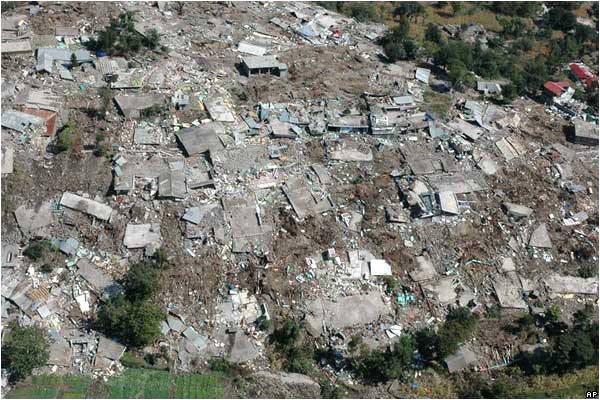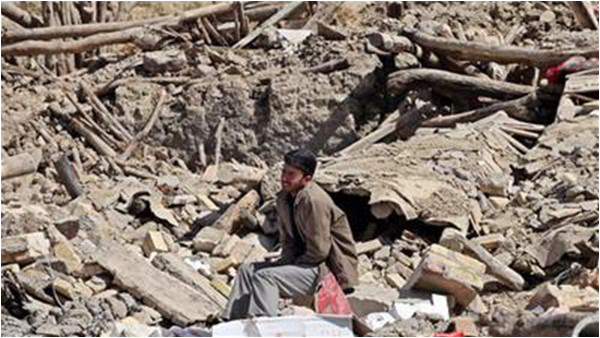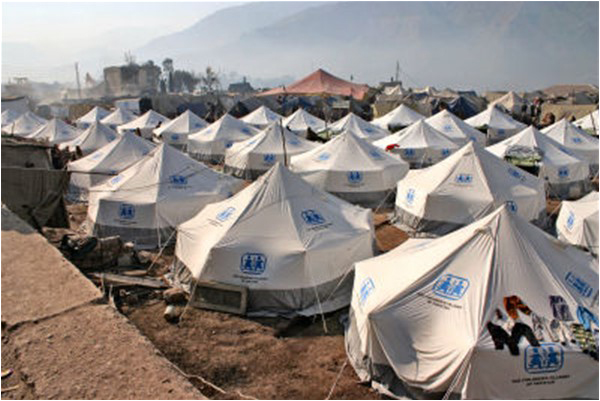
Sherrilyn Kenyon, a bestselling writer from the US, once said, “The worst wounds, the deadliest of them, aren’t the ones people see on the outside. They’re the ones that make us bleed internally.” Some wounds are indeed incurable. They continue to bleed both internally and externally. The wounds left by the 8th of October, 2005, are such.
It is painful and extremely difficult to write about such a horrible day of my life – which turned the lives of hundreds of thousands of people to total misery in a few seconds.
It was morning, but I think of it as a dark night. Countless people lost their loved ones in front of their very eyes. Few had the time to exchange words of sympathy with each other – as almost every family had lost at least one member or a house – and all faced a highly uncertain future.
Either there is a scarcity of the appropriate words to describe such things, or else I lack the competence to use them – for I cannot draw anything resembling an accurate picture of that terrible morning. I believe nobody can.
How does one explain or narrate the feelings of an injured son standing on the debris of his devastated house, hoping for a miracle to save his mother, who is buried alive in the same building? Hundreds of such scenes flash before my eyes – where I saw for myself the transformation of a life’s springtime into an eternal autumn.
I have seen many mothers carrying the dead bodies of their children in their hands, asking others to see if they are alive. In my neighbourhood, a ten-year-old girl Naina was wiping her mother’s tears with her both hands, saying that she was fine. Meanwhile, her mother was trying to pull her out from the big concrete pillar of their collapsed house, which had damaged both her legs. This was just a few minutes before her death. Words fail me.

Personally, I felt a sense of total helplessness. I believed that life could never be resumed after all this.
In Pakistan we often speak of the rapid expansion of towns and cities. That day, the graveyards suddenly expanded at a mindboggling rate. The premier of the State of Azad Jammu and Kashmir at that time, Sardar Sikandar Hayat Khan, described himself as the Prime Minister of a graveyard. The capital city of the state is still facing an acute shortage of land to be allocated for graveyards, today.
Given that this was the single largest natural disaster in the history of Pakistan and Kashmir, neither governments nor people were prepared for the challenging tasks of dealing with relief, rehabilitation and reconstruction on such a scale. No disaster management organisation existed to handle a relief operation at this level. The existing infrastructure was either very poor or totally destroyed.
However, feeling the pain of the people of Kashmir and Khyber-Pakhtunkhwa, the Pakistani people set an unprecedented example of generous contributions for the relief phase in the quake-hit areas of Azad Jammu and Kashmir. It is true that the Kashmiri people can never forget the disaster. But equally, they can never forget the love shown to them by their Pakistani brethren in that time.
According to government sources, more than 80,000 people perished as a result of the earthquake, while an estimated 4 million more were left homeless. Some independent institutions have reported that the death toll had crossed 100,000. Approximately 47,000 were injured. 19,000 children died in the earthquake – most of them in widespread collapses of school buildings. The earthquake affected more than 500,000 families.
Due to the massive destruction, many countries, international organisations and non-governmental organisations offered relief aid to the affected regions. The aid given was in the form of monetary donations and pledges, as well as relief supplies including food, medical supplies, tents and blankets. Rescue and relief workers were sent from different parts of the world to the region and they brought vital rescue equipment, including helicopters and other necessary tools.
Channelising the relief, rehabilitation and reconstruction efforts, the government of Pakistan setup Earthquake Rehabilitation and Reconstruction Authority (ERRA) as well as National Disaster Management Authority (NDMA) with the mandate to tackle natural calamities as well as to run the rehabilitation and reconstruction programs in the earthquake-hit areas of the country. Under the umbrella of ERRA, the State Earthquake Rehabilitation and Reconstruction Authority (SERRA) was set up in Azad Jammu and Kashmir, which played a leading role in facilitating the international donors as well as national institutions and non-governmental organisations.

SERRA has claimed that 69 percent of the necessary work on reconstruction projects has been done in the earthquake-affected areas of the state. Official sources say that a total of 7,742 projects were planned, out of which 5,282 projects have been completed, while work on 1,497 projects is in progress. Work on 907 projects could not be started due to a lack of funds.
The organisation has completed 1,375 construction projects for educational institutions, out of a total of 2,798. Work on 745 projects is in progress, while the constructions of 677 schools buildings is yet to be started.
Mir Adnan Rahman, academic and activist, says: “The state of Azad Jammu and Kashmir learnt many lessons from that horrific catastrophe. Now there are non- governmental organisations and state-run institutions dedicated to provide training and enhance their capacity to cope efficiently with calamities in the future. The government needs to establish a strong and well-connected early warning mechanism across the state to take preventive and preparatory measures, in order to minimise the death toll and human suffering.”
According to geologists, this region is a highly hazardous zone and such natural calamities may occur in the future, too. Moreover, since the state of Azad Jammu and Kashmir is the part of the larger conflict between India and Pakistan over the erstwhile State of Jammu and Kashmir, and a significant segment of the divided population of the former state lives along the unnaturally divided LOC. As this entire region may see such disasters in the future, at the very least there is a need to set up cross-LOC confidence-building measures between India and Pakistan to ensure effective and rapid rescue and relief operations in times of natural calamities.
Mubashar Naqvi is a freelance writer based in Muzaffarabad. He was part of the relief, rehabilitation and reconstruction projects in quake-hit areas. He may be reached at mubashar_naqvi@yahoo.com
It is painful and extremely difficult to write about such a horrible day of my life – which turned the lives of hundreds of thousands of people to total misery in a few seconds.
It was morning, but I think of it as a dark night. Countless people lost their loved ones in front of their very eyes. Few had the time to exchange words of sympathy with each other – as almost every family had lost at least one member or a house – and all faced a highly uncertain future.
Either there is a scarcity of the appropriate words to describe such things, or else I lack the competence to use them – for I cannot draw anything resembling an accurate picture of that terrible morning. I believe nobody can.
How does one explain or narrate the feelings of an injured son standing on the debris of his devastated house, hoping for a miracle to save his mother, who is buried alive in the same building? Hundreds of such scenes flash before my eyes – where I saw for myself the transformation of a life’s springtime into an eternal autumn.
I have seen many mothers carrying the dead bodies of their children in their hands, asking others to see if they are alive. In my neighbourhood, a ten-year-old girl Naina was wiping her mother’s tears with her both hands, saying that she was fine. Meanwhile, her mother was trying to pull her out from the big concrete pillar of their collapsed house, which had damaged both her legs. This was just a few minutes before her death. Words fail me.

Personally, I felt a sense of total helplessness. I believed that life could never be resumed after all this.
In Pakistan we often speak of the rapid expansion of towns and cities. That day, the graveyards suddenly expanded at a mindboggling rate. The premier of the State of Azad Jammu and Kashmir at that time, Sardar Sikandar Hayat Khan, described himself as the Prime Minister of a graveyard. The capital city of the state is still facing an acute shortage of land to be allocated for graveyards, today.
Given that this was the single largest natural disaster in the history of Pakistan and Kashmir, neither governments nor people were prepared for the challenging tasks of dealing with relief, rehabilitation and reconstruction on such a scale. No disaster management organisation existed to handle a relief operation at this level. The existing infrastructure was either very poor or totally destroyed.
However, feeling the pain of the people of Kashmir and Khyber-Pakhtunkhwa, the Pakistani people set an unprecedented example of generous contributions for the relief phase in the quake-hit areas of Azad Jammu and Kashmir. It is true that the Kashmiri people can never forget the disaster. But equally, they can never forget the love shown to them by their Pakistani brethren in that time.
I felt a sense of total helplessness. I believed that life could never be resumed after all this
According to government sources, more than 80,000 people perished as a result of the earthquake, while an estimated 4 million more were left homeless. Some independent institutions have reported that the death toll had crossed 100,000. Approximately 47,000 were injured. 19,000 children died in the earthquake – most of them in widespread collapses of school buildings. The earthquake affected more than 500,000 families.
Due to the massive destruction, many countries, international organisations and non-governmental organisations offered relief aid to the affected regions. The aid given was in the form of monetary donations and pledges, as well as relief supplies including food, medical supplies, tents and blankets. Rescue and relief workers were sent from different parts of the world to the region and they brought vital rescue equipment, including helicopters and other necessary tools.
Channelising the relief, rehabilitation and reconstruction efforts, the government of Pakistan setup Earthquake Rehabilitation and Reconstruction Authority (ERRA) as well as National Disaster Management Authority (NDMA) with the mandate to tackle natural calamities as well as to run the rehabilitation and reconstruction programs in the earthquake-hit areas of the country. Under the umbrella of ERRA, the State Earthquake Rehabilitation and Reconstruction Authority (SERRA) was set up in Azad Jammu and Kashmir, which played a leading role in facilitating the international donors as well as national institutions and non-governmental organisations.

SERRA has claimed that 69 percent of the necessary work on reconstruction projects has been done in the earthquake-affected areas of the state. Official sources say that a total of 7,742 projects were planned, out of which 5,282 projects have been completed, while work on 1,497 projects is in progress. Work on 907 projects could not be started due to a lack of funds.
The organisation has completed 1,375 construction projects for educational institutions, out of a total of 2,798. Work on 745 projects is in progress, while the constructions of 677 schools buildings is yet to be started.
Mir Adnan Rahman, academic and activist, says: “The state of Azad Jammu and Kashmir learnt many lessons from that horrific catastrophe. Now there are non- governmental organisations and state-run institutions dedicated to provide training and enhance their capacity to cope efficiently with calamities in the future. The government needs to establish a strong and well-connected early warning mechanism across the state to take preventive and preparatory measures, in order to minimise the death toll and human suffering.”
According to geologists, this region is a highly hazardous zone and such natural calamities may occur in the future, too. Moreover, since the state of Azad Jammu and Kashmir is the part of the larger conflict between India and Pakistan over the erstwhile State of Jammu and Kashmir, and a significant segment of the divided population of the former state lives along the unnaturally divided LOC. As this entire region may see such disasters in the future, at the very least there is a need to set up cross-LOC confidence-building measures between India and Pakistan to ensure effective and rapid rescue and relief operations in times of natural calamities.
Mubashar Naqvi is a freelance writer based in Muzaffarabad. He was part of the relief, rehabilitation and reconstruction projects in quake-hit areas. He may be reached at mubashar_naqvi@yahoo.com

